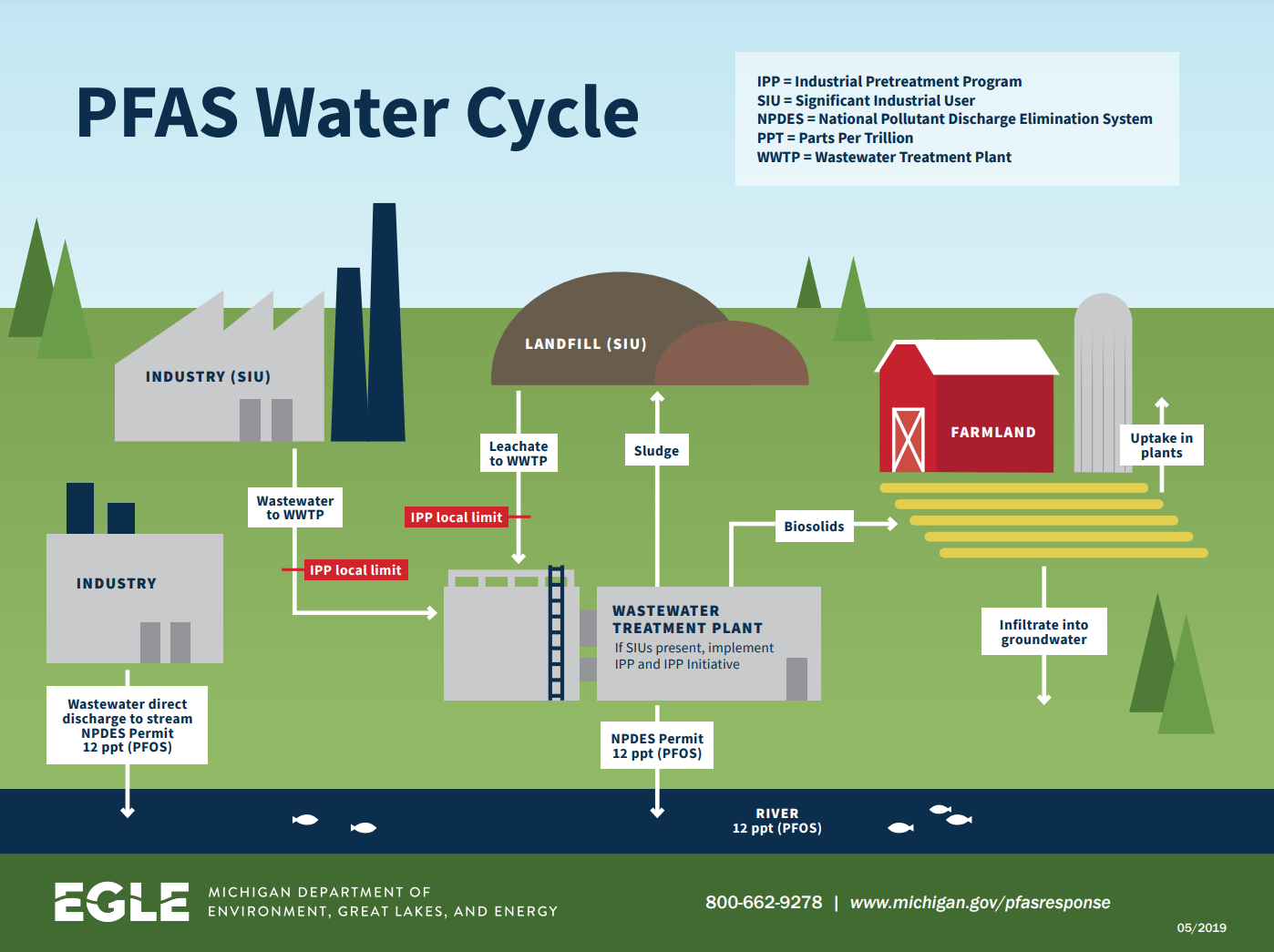PFAS - Per and Polyfluoroalkyl Substances
Michigan Department of Environment, Great Lakes, and Energy (https://www.michigan.gov/pfasresponse/0,9038,7-365-86510_88079-476131--,00.html)
“Per- and polyfluoroalkyl substances (PFAS) are a family of human-made chemicals that are found in a wide range of products used by consumers and industry. There are nearly 5,000 types of PFAS, some of which have been more widely used and studied than others. Many PFAS are resistant to grease, oil, water and heat. For this reason, beginning in the 1940’s, PFAS have been used for many different applications including in stain- and water-resistant fabrics and carpeting, cleaning products, paints, and fire-fighting foams, as well as in limited, authorized uses in cookware and food packaging and processing (referred to as food contact substances). Two types of PFAS that have been produced in the largest quantities in the U.S. and are among the most studied are perfluorooctanoic acid (PFOA) and perfluorooctane sulfonate (PFOS).
The widespread use of PFAS and their ability to remain intact in the environment means that over time PFAS levels from past and current uses can result in increasing levels of environmental contamination. Typically, contaminated ground water and soil is limited to a specific geographic area, for example, near an industrial facility where PFAS were produced or used to manufacture other products, or an oil refinery, airfield, or other location at which PFAS containing products were used for firefighting. Through environmental contamination PFAS can enter the food chain, for example, crops grown in contaminated soils or using water from a contaminated source. To a lesser extent, PFAS can also migrate, or transfer, into food from certain food contact materials such as, grease proofing agents in paper and paper board packaging. The use of PFAS in food contact substances must be authorized by the FDA – certain limited uses are authorized through our food contact notification program.
Accumulation of certain PFAS has also been shown to occur in humans and animals, as found through blood tests. While the science surrounding potential health effects of PFAS is developing, current evidence suggests that the bioaccumulation of certain PFAS may cause serious health conditions. Understanding and addressing this public health issue requires collaboration across local, state, and federal agencies. At the national level, the U.S. Environmental Protection Agency, the U.S. Department of Agriculture, the National Institutes of Health, the Centers for Disease Control and Prevention, and the U.S. Department of Defense are just some of the federal agencies the FDA is working with to advance knowledge on environmental contamination and potential associated health risks.
More on FDA efforts to estimate PFAS exposure from foods can be found in the Statement from Acting FDA Commissioner Ned Sharpless, M.D. and Deputy Commissioner Frank Yiannas on FDA’s scientific work to understand per- and polyfluoroalkyl substances (PFAS) in food, and findings from recent FDA surveys”. (FDA, 2019)
Additional Information on PFAS from Other Federal Government Agencies
Per-and Polyfluoroalkyl Substances (PFAS) and Your Health, The Agency for Toxic Substances and Disease Registry, the Centers for Disease Control and Prevention, U.S. Department of Health and Human Services
Per-and Polyfluoroalkyl Substances (PFAS), The United States Environmental Protection Agency
Additional Documents
click to enlarge
Source: City of Rockford, https://www.rockford.mi.us/PFASandTanneryinfo/tabid/11878
Wolverine Community Advisory Group (CAG) FOR Kent Count, MI
Meetings for the Wolverine Community Advisory Group - Kent County, MI are held at Plainfield Charter Township Hall, 6161 Belmont Ave NE, Belmont MI 49306 the third Thursday of the month, at 6pm. Due to the ongoing pandemic, the meetings are currently on Zoom.
You can watch the recorded meetings here









